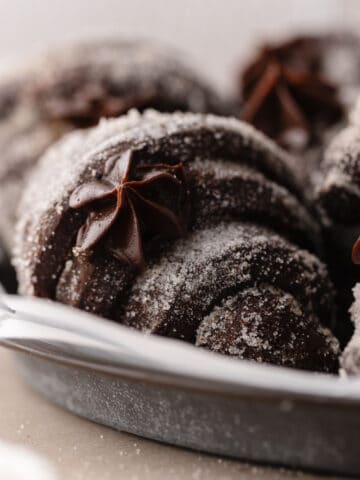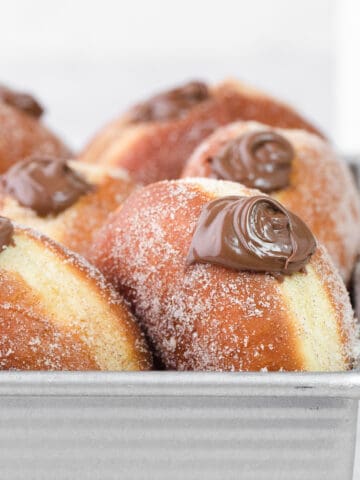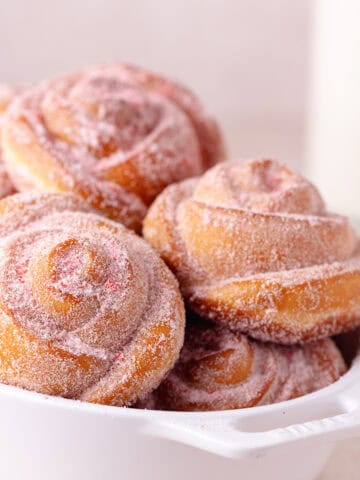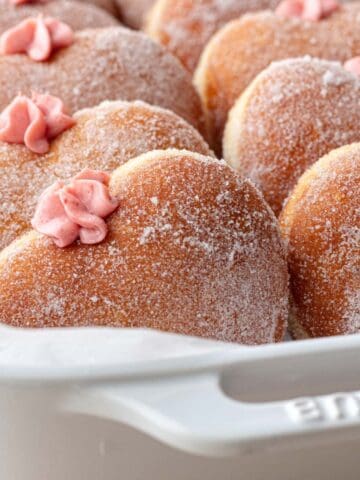Soft and fluffy fried Cinnamon Toast Crunch Donuts dipped in a cereal milk glaze and coated in cinnamon toast crunch cereal crumbs! A craveworthy treat perfect for any time of year!

As you may already know, I am a sucker for donuts. Donuts that are fried until golden perfection. Baked donuts are great, but nothing beats the real thing. I know the thought of frying dough may seem a bit intimidating, but once you try it, it's actually quite easy. I've included a ton of tips and detailed notes to help you along the way. As long as your oil temperature is correct, you'll never have greasy homemade donuts.
A few weeks ago, I posted a delicious Cinnamon Toast Crunch Cookie recipe and I thought how fun it would be to create some cinnamon toast crunch donuts!
These donuts are a sweet, yeast-leavened dough that has been flavored with cinnamon toast crunch cereal milk and a bit of ground cinnamon to enhance the cozy flavors. The donuts are then quickly fried until golden brown. Once slightly cooled, the donuts get dipped in a delicious cereal milk glaze and then crumb coated in cinnamon toast crunch cereal crumbs.
Jump to:
♡ Why You Will Love These Cinnamon Toast Crunch Donuts
- Flavor. The flavor is lovely. It reminds me of a crumb donut that you would get at a donut shop.
- Amazing texture. These donuts are so soft and fluffy. In fact, they stay soft for up to 3 days! The key is to refrain from adding too much flour in the dough and to use dry milk powder. I use it in nearly all my sweet yeast and brioche doughs.
- Versatile. The great thing is, if you're not a fan of cinnamon toast crunch cereal, you can swap it out for your favorite cereal.

Ingredient Notes
Here are some notes about all the ingredients used in these Cinnamon Toast Crunch Donuts. Quantities and full instructions are in the recipe card below!

Donut Dough Ingredients
- Yeast - I'm using active dry yeast, but you can also use instant yeast. I've included notes in the recipe card below.
- Cinnamon Toast Crunch Cereal - We'll be soaking the cereal with some milk to create a "cereal milk." The cereal milk will be divided to use in yeast dough and in the glaze. We'll also coat the donuts in finely ground cinnamon toast crunch cereal.
- Whole Milk - Whole milk is best.
- White Sugar - A little bit of brown sugar will feed the yeast and will also be in the dough.
- Flour - We're using a combination of Bread Flour and All-Purpose Flour for the perfect chewy and soft texture.
- Dry Milk Powder - Don't skip this ingredient. This will help keep our homemade donuts softer for longer. I use it nearly all my sweet yeast-leavened doughs like my Nutella Cinnamon Rolls, Almond Croissant Rolls, and Cinnamon Apple Babka.
- Butter - We'll be using melted butter, which makes it easy to incorporate into the dough.
- Egg + Yolk - Adds structure and the extra yolk adds richness.
- Cinnamon - Adds flavor.
- Salt - A flavor enhancer and make donuts fluffy.
- Vanilla Extract - For flavor.

Glaze + Coating Ingredients
- Reserved Cereal Milk
- Powdered Sugar - Also known as confectioners' sugar or icing sugar.
- Butter - We'll be adding a bit of melted butter into the glaze to add richness and flavor.
- Vanilla Extract - For flavor.
- Ground Cinnamon - For extra flavor.
- Cinnamon Toast Crunch Cereal - Finely ground Cinnamon Toast Crunch Cereal will be used to crumb coat the donuts.
*See recipe card for quantities.
Step-By-Step Instructions
Here are step-by-step photos and instructions on how to make these Cinnamon Toast Crunch Donuts! Please find detailed instructions in the recipe card at the end of this post.

Step 1. Make Cereal Milk - Allow milk and cinnamon toast crunch cereal to soak for 15 minutes. Then drain the milk and discard the cereal. Divide ¾ cup (171g) of the cereal milk for the dough and keep the remainder in the fridge for the glaze.

Step 2. Warm ¾ cup of the cereal milk and then combine with yeast. Allow to bloom for 5 to 7 minutes. Mixture should be frothy

Step 3. Combine Ingredients - To a large bowl, add bread flour, all-purpose flour, milk powder, melted butter, 1 egg, 1 yolk, white sugar, cinnamon, salt, vanilla and frothy yeast mixture.

Step 4. With a spoon, mix the ingredients together until it becomes a shaggy ball.

Step 5. Knead the Dough - Fit your stand mixer with the dough hook attachment and knead on medium/high speed for about 15 minutes.

Step 6. Window Pane Test - The dough is properly kneaded when it's passes the window pane test.
💡 Tip
Window pane test - Take a small ball of dough and stretch it thin enough to let light pass through without tearing. If it tears, knead for an additional 1 to 2 minutes.

Step 7. Let Double in Size - Form the dough into a ball and then place it into a lightly oiled bowl (I used the same stand mixer bowl). Cover with plastic wrap and allow to rise in a warm place for an hour or until it doubles in size.

Step 8. Divide the Dough - Using a kitchen scale, weigh the entire dough and then divide by 10. Each dough ball should weigh around 75 grams each.
How to Shape Cinnamon Crunch Donuts

Step 9. Shape Into Buns - Grab a piece of dough and press it flat to get rid of any air bubbles. Gather and pinch the edges together and then place it on your work surface seam side down. Form your hand into a relaxed “claw” shape and cup it over the ball of dough. Then move your hand in small circular motions, gently dragging the ball along until smooth. Flip it over to make sure the seams are closed.


Step 10. Shape the Donuts - Dip your pointer finger into some flour and create a hole in the center of the bun, piercing all the way through. Then twirl it around your pointer finger, rotating several times. As the hole gets larger, wrap it around both pointer fingers and roll in a circular motion. You'll want it to be at least 1.5 inches (3.8 cm) wide as the hole will shrink a little.

Step 12. Proof Donuts - Place donuts on parchment paper squares and transfer to a large baking tray. Loosely cover with plastic wrap that has been sprayed with a bit of oil and allow to rise for about 45 minutes or until it passes the “poke” test. It may take less time if you are using instant yeast, so check after 25 minutes.

Step 13. Fry Donuts - Once the oil reaches 350ºF (176ºF), fry 2 to 3 donuts at a time for 1 minute and 15 seconds on each side. Transfer fried donuts to a cooling rack lined with paper towels.
💡 Tip
The warmer the kitchen, the quicker the donuts will fully proof. When I use dry active yeast, it generally takes about 40 to 45 minutes. In order to know when the donuts are done, you should always perform a "poke" test. Gently press your pointer finger on to the dough and if it springs back slowly and leaves a slight indentation, then it’s ready to be fried. If the dough bounces back immediately, then it needs more time.

Step 14. Glaze the Donuts - Dip the tops of the donuts into the glaze, allowing the excess to drip off.

Step 15. Crumb Coat the Donuts - Then immediately dip into the cinnamon toast crunch cereal crumbs. Serve and enjoy!

Substitutions
- Bread Flour - If you don't have bread flour in your pantry, you can just use all-purpose flour. Keep in mind that you may need to add a bit more AP flour because bread flour (high protein) absorbs more liquid.
- Yeast – I almost always only use Active Dry Yeast, but you can also use instant yeast. If using instant yeast, there is no need to activate it in the milk. Just combine all of the dough ingredients together into the mixing bowl and proceed as written. You'll still want to warm the milk though.
- Cinnamon Toast Crunch Cereal - If you are not a fan of CTC, you can use other cereals such as, Fruit Loops, Cocoa Puffs, Apple Jacks, Lucky Charms, Fruity Pebbles or Corn Flakes.
Key Equipment
- Electric Mixer - While having a stand mixer is extremely helpful, you can also knead by hand. Please see directions in the FAQ section below.
- Thermometer - Having a thermometer that can clip to the side of the pot is crucial in order to monitor the temperature of the oil as you fry.
- Kitchen Scale - It’s helpful to have when measuring ingredients accurately.
Storage
- Room Temperature - Donuts are best when eaten the same day, but you can keep it on the counter for up to 3 days. I like to store leftovers in a container, but keep it loosely covered. This will keep the glaze from breaking down and making the donuts wet.
- Refrigerator - Donuts can be stored in an airtight container for 3 to 4 days in the fridge. Allow to come to room temperature before serving.

✨ Expert Tips
Use a kitchen scale to weigh all your ingredients. Baking in grams rather than in volume, is the best and most accurate way to bake! All my recipes include gram conversions based on King Arthur's Weight Chart.
If you are not using a kitchen scale, measure your flour correctly. Fluff and aerate your flour first, then spoon into your measuring cup and finally level off with the back of a butter knife. Do not pack it in as it will add too much flour.
Make sure your yeast is fresh. If you are unsure, check by blooming a tiny bit of active dry yeast or instant yeast in warm liquid with a bit of sugar. Nothing is worse than continuing on with a recipe, and then discover later that your yeast is dead.
Kneading your dough until it passes the window pane test. To perform the test, take a small (2 tbsp) ball of dough and stretch it thin enough to let light pass through without tearing it. If it tears, knead for an additional 1 to 2 minutes.
Perform a “poke” test to know your donuts are properly proofed! Gently press your pointer finger into the dough and if it springs back slowly and leaves a slight indentation, it’s ready to be fried. If the dough bounces back immediately, then it needs more time.
Use a thermometer to consistently check the oil’s temperature. It can rise and lower as you move through the frying process. Keep a close eye on the temperature to ensure it stay between 350ºF to 360ºF (176ºC to 182ºC). If the temperature of your oil is too low, your donuts run the risk of absorbing too much oil and if the oil is too hot, the donuts will brown too quickly and the center can be uncooked.
Be prepared before you start frying your donuts. After the donuts are done proofing, this recipe moves quickly. Have your oil heated to temperature with a thermometer clipped to your pot, a cooling rack lined with paper towels and your glaze/topping ready.
FAQ
Yes, you can! You will just need to knead the dough by hand for up to 20 minutes. It can get quite sticky, but refrain from adding too much flour. I like to knead the dough with oiled hands and use a plastic bench scraper to help move the dough around. Don’t forget to perform the window pane test to know that it has been properly kneaded.
I like to use vegetable shortening, but you can use any oil with a high smoke point. You can use canola oil, avocado oil (very expensive though), grapeseed oil, vegetable oil or sunflower oil.
Allow the oil to cool completely in the pot, then pour back into its original container or a plastic bag and throw it away in the trash. It should never be poured down the drain, as it could potentially clog your pipes.
A cake donut contains baking powder to help them rise when fried, whereas yeast donuts rely on yeast to rise. The texture of cake donuts are more cakey and yeast donuts are more like bread.

You May Also Like
♡ Did you try this recipe?
Please consider leaving a 5-star rating and review below. This provides helpful feedback to myself and other readers. Thank you so much!
📖 Recipe

Cinnamon Toast Crunch Donuts
- Total Time: 2 Hours + 35 Minutes
- Yield: 10
Description
Soft and fluffy fried Cinnamon Toast Crunch Donuts dipped in a cereal milk glaze and coated in cinnamon toast crunch cereal crumbs! A craveworthy treat perfect for any time of year!
Ingredients
Donut Dough
- 1 ½ Cup (61g) Cinnamon Toast Crunch
- 1 Cup + 3 Tablespoons (270g) Whole Milk, will be divided ¾ Cup for donuts dough & the remainder will be for glaze
- 1 ½ Teaspoon (5g) Active Dry Yeast
- ¼ Cup + 1 Teaspoon (50g + 4g) Granulated White Sugar, divided
- 3 Tablespoons (42g) Unsalted Butter, melted
- 1 Large Whole Egg + 1 Yolk, room temp
- 1 Teaspoon Vanilla Extract
- 1 ½ Cups + 2 Tablespoons (195g) Bread Flour
- 1 ½ Cups (180g) All-Purpose Flour
- 3 Tablespoons Dry Milk Powder
- ¾ Teaspoon Cinnamon
- ¾ Teaspoon Fine Sea Salt
Cereal Milk Glaze
- 1 ½ Cup Powdered Sugar
- 2 Tablespoons (28g) Melted Butter
- ¾ Teaspoon Vanilla Extract
- ½ Teaspoon Cinnamon
- 3 to 4 Tablespoons Reserved Cereal Milk
Coating
- 1 Cup (41g) Cinnamon Toast Crunch Cereal, finely crushed
Instructions
- Make Cereal Milk - In a medium bowl, combine cinnamon toast crunch cereal and the milk and allow to soak for 15 minutes. Drain the milk and then discard the cereal. Divide ¾ cup (171g) of the cereal milk for the dough and keep the remainder in the fridge for the glaze.
- Bloom the Yeast - In a measuring cup or small bowl, add warm (105ºF) cereal milk, 1 teaspoon of white sugar and 1 ½ teaspoons of active dry yeast. Stir well to combine and let bloom for 5 to 7 minutes. see note below for instant yeast
- Combine all Ingredients - To the a large bowl or stand mixer bowl, add bread flour, all-purpose flour, dry milk powder, frothy yeast mixture, melted butter, egg, yolk, cinnamon and salt. With a spoon or spatula, mix all the ingredients together until it becomes a shaggy ball.
- Knead the Dough - Fit your stand mixer with the dough hook attachment and knead on medium/high speed for about 15 minutes or until it passes the window pane test. If it's a bit sticky, you can gradually add 1 to 2 tablespoons of bread flour. See notes below regarding window pane test.
- Let Double in Size - Form dough into a ball, then place into a lightly oiled bowl (I used the same stand mixer bowl). Cover with plastic wrap and allow to rise in a warm place for about an hour or until it doubles in size. If using instant yeast, it will take less time.
- Prep the Parchment Squares - When the dough has almost doubled in size, cut out 10, 4x4 inch (10x10 cm) parchment paper squares.
- Divide the Dough - Gently deflate the dough and transfer it onto a lightly floured work surface. Divided the dough into 10 equal pieces, by weighing the entire dough with a kitchen scale and then divide that number by 10. You should about 75 grams per piece.
- Roll into Smooth Balls - Grab a piece of dough and press it flat to get rid of any air bubbles. Gather and pinch the edges together and then place it on your work surface seam side down. Form your hand into a relaxed “claw” shape and cup it over the ball of dough. Then move your hand in small circular motions, gently dragging the ball along. It will tighten and the top will become smooth. Please see the photos in the body of the post as a reference.
- Shape the Donuts - Dip your pointer finger into some flour and create a hole in the center of the bun, piercing all the way through. Then twirl it around your pointer finger, rotating several times. As the hole gets larger, wrap it around both pointer fingers and roll in a circular motion. You'll want it to be at least 1.5 inches (3.8 cm) wide as the hole will shrink a little.
- Proof Donuts - Place donuts onto the parchment paper squares and transfer to a large baking tray. Loosely cover with plastic wrap that has been sprayed with a bit of oil and allow to rise for about 45 minutes or until it passes the “poke” test. See note below.
- Prep the Oil - With 25 minutes left of proofing, fill a medium to large sized pot with at least 2 inches of vegetable shortening or neutral oil such as canola, vegetable, or avocado oil. Clip a thermometer on the side of the pot and heat until it registers between 350ºF (167ºC) and 360ºF (182ºC).
- Prep the Glaze - In a bowl, combine powdered sugar, melted butter, vanilla, cinnamon and 3 tablespoons of the reserved cereal milk. Whisk well until you reach your desired consistency. If you'd like a thicker glaze, add less milk, if you'd like a thinner glaze, add more milk. If you run out of the cereal milk, you can use regular milk. If the glaze is too thin, add more powdered sugar. Set glaze aside.
- Prep the Coating - Add a cup of cinnamon crunch cereal to a sturdy ziploc bag and seal it. Use a rolling pin or the bottom of a heavy pot and crush the cereal until you have fine crumbs. Pour into a shallow bowl or plate and set aside.
- Additional Prep - Line a baking sheet with paper towels and set aside. Grab all the tools you'll need such a kitchen spider or slotted spoon and tongs for removing the parchment paper.
- Fry the Donuts - Once the donuts are proofed and the oil reaches 350ºF (180ºF), carefully place 2 to 3 donuts into the hot oil with the parchment paper. After a few seconds, use tongs and remove the papers. Fry for 45 seconds on each side. Then flip the donuts and fry for an additional 20 seconds on each side. Set a timer! Scoop and drain the donuts well and then transfer to a cooling rack that has been lined with paper towels.
- Glaze & Crumb Coat the Donuts - When the donuts are cool enough to handle, dip the tops of the donuts into the glaze, allowing the excess to drip off. Then immediately dip the donuts into the cinnamon toast crunch cereal crumbs. Serve and enjoy!
Notes
Cereal Milk - Please note that you'll only need to use ¾ cup of the cereal milk for the dough. The remaining will be used for your glaze, although you may not need to use everything.
Instant Yeast - If you are using instant yeast, there is no need to activate it. Just combine all the dough ingredients into your mixing bowl, making sure your cereal milk is warm (105ºF). Keep in mind your rise and proof time may be a little shorter.
Window Pane Test - The dough is properly kneaded when it's passes the window pane test. Take a small ball of dough and stretch it thin enough to let light pass through without tearing. If it tears, knead for an additional 1 to 2 minutes.
Proofing Note - The warmer the kitchen, the quicker the donuts will fully proof. When I use dry active yeast, it generally takes about 40 to 45 minutes. In order to know when the donuts are done, you should always perform a "poke" test. Gently press your pointer finger on to the dough and if it springs back slowly and leaves a slight indentation, then it’s ready to be fried. If the dough bounces back immediately, then it needs more time.
- Prep Time: 45 Minutes
- Rise/Proof Time: 1 Hr + 45 Minutes
- Cook Time: 5 Minutes Total









Leave a Rating and Comment